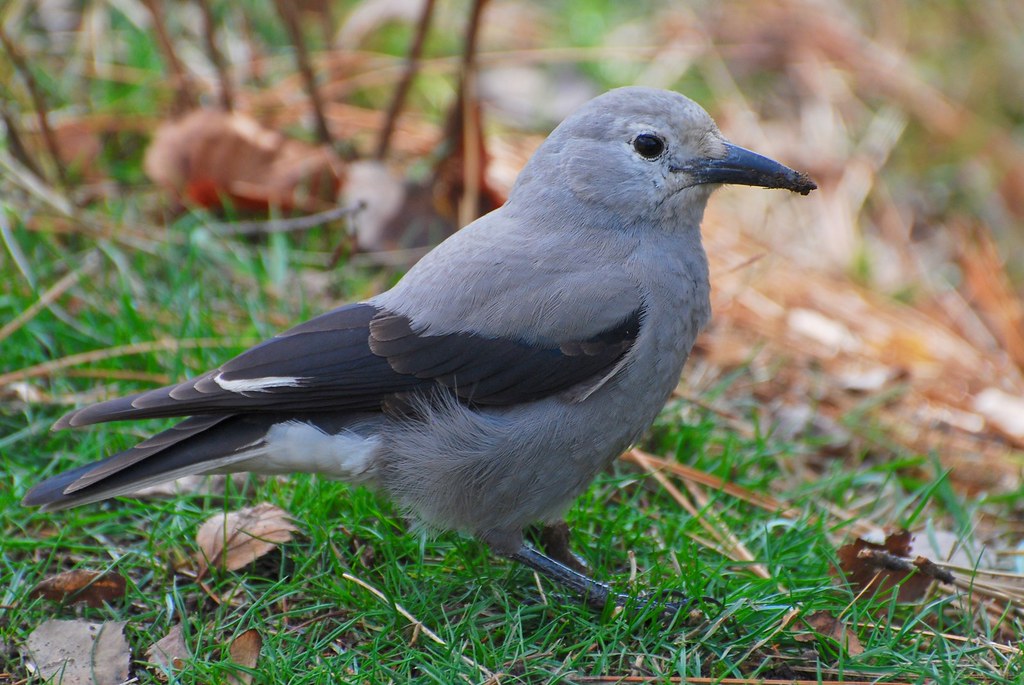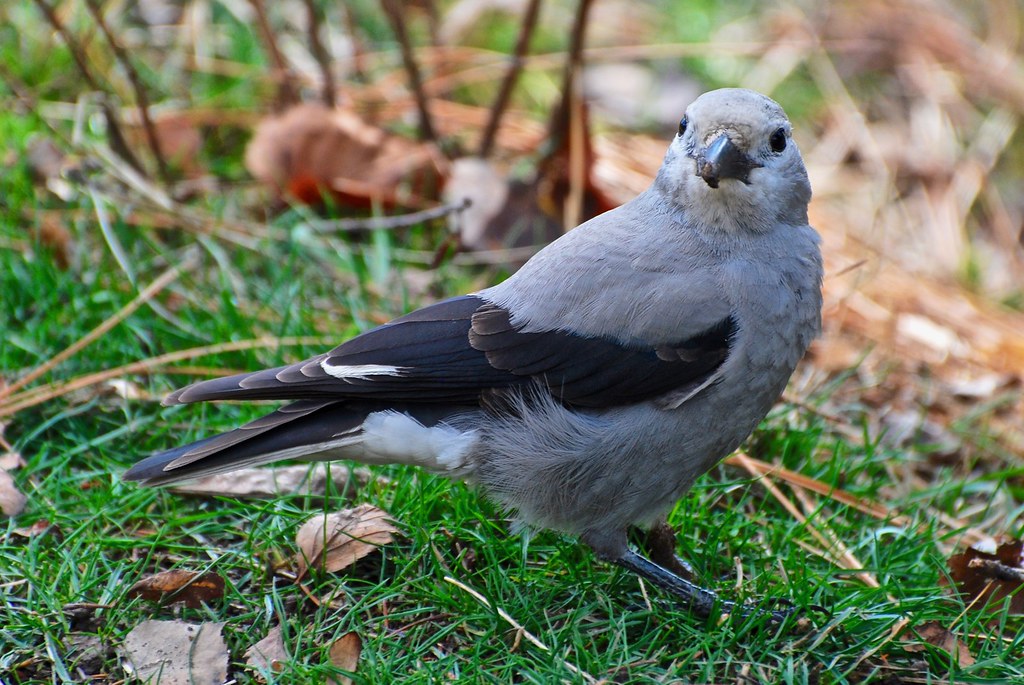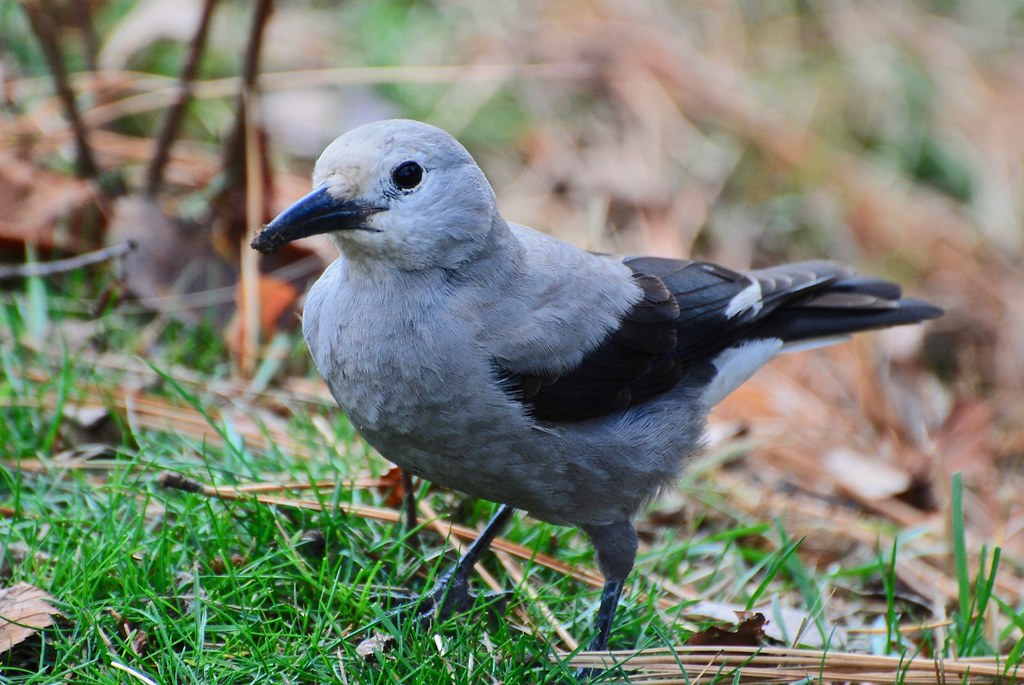November 16, 2017
Clark’s Nutcracker
These birds are large, about the size of Blue Jays, and inhabit the higher mountain areas of the west. They pull out seeds from the cones of pine trees, especially White Pines, stash them in a pouch under their tongue and then bury them in a cache for the winter. Each bird will bury tens of thousands of seeds during the summer and will remember the locations of most of them: the ones they can’t find plant more trees. It is said that some birds will plant trees but the Clark’s Nutcracker will plant forests.
I had always read that the seeds of the White Pine were a large part of a Grizzly Bear’s diet, but I could never figure out how such a huge bear was able to get the seeds from the cones. I later read that they will sniff out the large caches of seeds buried by the Nutcrackers and feed on those.

Clark’s Nutcracker ~ Nucifraga columbiana


RSS feed for comments on this post. TrackBack URI



It’s a pretty bird and you got some great shots of it. It was nice of it to pose so well, and I’m happy to hear that they’re out there planting trees. Nature never fails to amaze me!
LikeLiked by 1 person
Comment by New Hampshire Garden Solutions — November 16, 2017 @ 4:35 pm
They usually stay high on the mountains (over 6,000 feet), but occasionally a small flock will visit down here. This afternoon when walking with Buster I found one that let me get quite close and was able to get a few photos. They are among my favorite birds. They are very beneficial for both the bears and the forests!
LikeLike
Comment by montucky — November 16, 2017 @ 4:44 pm
Oh wow. Impressive.
Sent from my iPhone
>
LikeLiked by 1 person
Comment by Marcia Williams — November 16, 2017 @ 5:05 pm
They are fascinating birds!
LikeLike
Comment by montucky — November 16, 2017 @ 5:18 pm
Very cool bird!
LikeLiked by 1 person
Comment by centralohionature — November 16, 2017 @ 5:20 pm
“Cool” is a good word for them. They usually live in the very cold regions of the higher mountains. I wonder if these will stay down here for the winter.
LikeLike
Comment by montucky — November 16, 2017 @ 8:12 pm
Very interesting post and wonderful close ups of the jay (I presume he’s a type of jay)?
LikeLiked by 1 person
Comment by wordsfromanneli — November 16, 2017 @ 6:10 pm
The Nutcracker is a member of the crow and Jay family. It is the size of a Jay, but has mostly the shape of the Crow.
LikeLiked by 1 person
Comment by montucky — November 16, 2017 @ 8:16 pm
I wonder if it is a nest robber like the crows and ravens. It’s amazing how they are planters of seeds.
LikeLike
Comment by wordsfromanneli — November 16, 2017 @ 8:56 pm
No, they are not, just seed specialists.
LikeLiked by 1 person
Comment by montucky — November 16, 2017 @ 8:59 pm
Oh, that’s good. I won’t put them on my black list.
LikeLiked by 1 person
Comment by wordsfromanneli — November 17, 2017 @ 10:10 am
Were there such a thing as reincarnation, I would want to return as a Clark’s Nutcracker!
LikeLiked by 1 person
Comment by montucky — November 17, 2017 @ 8:43 pm
I’ll keep that in mind and wave to you when we’re in the next world, whatever that may be.
LikeLiked by 1 person
Comment by wordsfromanneli — November 18, 2017 @ 9:08 am
What a fine-looking bird. You certainly were able to get some great photos. It’s interesting how many birds (and other creatures) will cache food, and how much they’ll put away. I couldn’t help thinking of this video of an antenna that went off-line because of an acorn cache. The title says “squirrel,” but it says elsewhere they suspected a woodpecker.
LikeLiked by 1 person
Comment by shoreacres — November 16, 2017 @ 6:34 pm
That was one very busy woodpecker! I wonder how long it took him to collect all of those!
LikeLike
Comment by montucky — November 16, 2017 @ 8:18 pm
Great images, Terry. The bird almost looks like its posing for you.
How interesting to read of their seed burying habits making some new trees for the wilderness area.
I was watching a movie only a couple of days ago where a massive grizzly attacked a camper and despite the blood & gore make-up of the victim, when the camera switched to what was obviously a real grizzly, I was amazed at the size as it stood on its hind legs. I’m not surprised its sense of smell can detect the smallest bit of food. I could actually imagine it breaking a pine cone itself 🙂 (even though it doesn’t).
LikeLiked by 1 person
Comment by Vicki — November 16, 2017 @ 7:00 pm
It would take a lot of seeds to satisfy a Griz, but I suppose a few thousand from each cache… Many years ago I did see Grizzly scat in the area where I usually see the Nutcrackers.
LikeLiked by 1 person
Comment by montucky — November 16, 2017 @ 8:20 pm
With that impressive beak he is obviously well equipped for his task!
LikeLiked by 1 person
Comment by de Wets Wild — November 16, 2017 @ 7:50 pm
That’s the tool of his trade. They are big birds and very well equipped to live where they do. I wonder how they figure out where to bury the seeds so they can find them in the deep snow.
LikeLiked by 1 person
Comment by montucky — November 16, 2017 @ 8:22 pm
That’s lovely to know! What an important role he plays!
LikeLiked by 1 person
Comment by Jo Woolf — November 17, 2017 @ 3:29 am
Yes, his is a very beneficial species. I wish we humans could say that.
LikeLiked by 1 person
Comment by montucky — November 17, 2017 @ 8:45 pm
Wonderful portraits!
It is interesting to consider their relationships with their food and planting forest and feeding bears, the later surely does not please them…. though who knows 😉
LikeLiked by 1 person
Comment by Tammie — November 17, 2017 @ 8:58 am
Hiding enough to feed a large bear is impressive, but I can think of many other creatures that plant seeds regularly as part of securing their own food supply.
LikeLike
Comment by montucky — November 17, 2017 @ 8:49 pm
You got some really good shots of this pretty bird. How interesting that they bury their seeds for later (and for those bears evidently).
LikeLiked by 1 person
Comment by Mama's Empty Nest — November 17, 2017 @ 10:20 am
They have developed a very close relationship to white pines in particular. Where one lives well, so does the other.
LikeLike
Comment by montucky — November 17, 2017 @ 8:52 pm
I love listening to them from the tent. They always make sure we don’t oversleep, lol.
LikeLiked by 1 person
Comment by derwoodynck — November 17, 2017 @ 12:43 pm
They are brash and bold and a little loud. I love them for that!
LikeLike
Comment by montucky — November 17, 2017 @ 8:53 pm
What a cool looking bird!😁
LikeLiked by 1 person
Comment by heartandsoul974 — November 17, 2017 @ 8:02 pm
It is a cold weather bird, as can be seen by the positions and thickness of the feathers. When I first became acquainted with them I was amazed that they could live in the cold places where they do.
LikeLiked by 1 person
Comment by montucky — November 17, 2017 @ 8:55 pm
I think cold weather birds are the most beautiful! We have little chickadees that are here all winter and sometimes cedar waxwings, although I’m not sure if they stay the whole winter.
LikeLiked by 1 person
Comment by heartandsoul974 — November 18, 2017 @ 6:49 am
We have Chickadees here too. That is my favorite bird! They stay with us even through the coldest winter. I keep sunflower seeds in a special feeder for them all winter.
LikeLiked by 1 person
Comment by montucky — November 18, 2017 @ 9:04 pm
I’ll have to get a bird feeder as well. Hopefully the bears are hibernating so they won’t get into it.
LikeLiked by 1 person
Comment by heartandsoul974 — November 19, 2017 @ 7:47 am
Yes, bears can be a problem until they den up for the winter. I have a hanging feeder and another which is just an open tray. The winter birds like both (and I put some seeds on the ground under the woodpile shelter for the ground feeders.
LikeLiked by 1 person
Comment by montucky — November 19, 2017 @ 7:26 pm
I need to put out bird food for the chickadees.
LikeLiked by 1 person
Comment by heartandsoul974 — November 21, 2017 @ 4:44 am
They would really appreciate it! They stay loyal all through the winter.
LikeLiked by 1 person
Comment by montucky — November 21, 2017 @ 10:48 am
Beautiful photos, Terry.
LikeLiked by 1 person
Comment by seekraz — November 17, 2017 @ 9:03 pm
Thanks Scott!
LikeLiked by 1 person
Comment by montucky — November 17, 2017 @ 9:08 pm
Never knew of this Nutcracker before! No wonder. We haven’t got those in Sweden. The Swedish Nutcracker is of different colors. Brown with lots of whitish spots. Otherwise it looks quite similar. Maybe you’ve got it in America too?
Ellington
LikeLiked by 1 person
Comment by Arletta Ellington — November 18, 2017 @ 2:53 am
I don’t believe we have the Swedish Nutcracker here. It looks quite similar except for the colors, so they are probably close relatives.
LikeLiked by 1 person
Comment by montucky — November 18, 2017 @ 9:02 pm
Hope you can see this picture of the Nutcracker that we have here in Sweden. The picture is from the site “Artportalen” (Species observation portal): https://www.artportalen.se/Image/1972455
Ellington
LikeLiked by 1 person
Comment by Arletta Ellington — November 19, 2017 @ 1:33 am
Thanks for the link! They are really speckled, but other than coloring, quite similar to the Clark’s.
LikeLiked by 1 person
Comment by montucky — November 19, 2017 @ 7:28 pm
Clark’s Nutcracker looks bright. I wonder if he eats the honey that the bear finds 🙂
The crows have a learning curve like a 3 year old child so I’ve heard and apparently a brilliant memory too!
LikeLiked by 1 person
Comment by Hanna — November 18, 2017 @ 10:05 am
By their actions, they appear as very smart birds.
LikeLike
Comment by montucky — November 18, 2017 @ 9:07 pm
Clever grizzlies. That’s quite a memory these birds have. Wikipedia says: “Closely tied in with this storage behavior is the bird’s remarkable long-term spatial memory; they are able to relocate caches of seeds with remarkable accuracy, even nine months later, and even when the cache sites are buried under up to a meter (3 ft) of snow.” Three feet of snow!?! Hmmm. How do they get them out? Maybe they just dive bomb from a nearby branch. 🙂
LikeLiked by 1 person
Comment by Sally — November 18, 2017 @ 5:06 pm
I’ve read that Chickadees also have a memory like that. With both, their lives depend on it.
LikeLiked by 1 person
Comment by montucky — November 18, 2017 @ 9:08 pm
Yup, they do — and a brain that grows over the summer to remember where they stored all the seeds. Incredible.
LikeLiked by 1 person
Comment by Sally — November 19, 2017 @ 9:38 am
Both species are incredible birds!
LikeLiked by 1 person
Comment by montucky — November 19, 2017 @ 7:24 pm
Cool! I keep hoping to see one of these when we go to the higher elevations but, so far, no luck. A grizzly must have to eat a ton of those seeds to fill up!
LikeLiked by 1 person
Comment by Candace — November 19, 2017 @ 2:59 pm
I don’t remember seeing them in Arizona, but there should be some around above the rim. Grizzlies are omnivores but I’m sure they get as many pine seeds as they can.
LikeLiked by 1 person
Comment by montucky — November 19, 2017 @ 7:23 pm
Handsome bird and so clever .. adept at tree planting 🙂
LikeLiked by 1 person
Comment by Julie@frogpondfarm — November 21, 2017 @ 3:25 am
It is a very beneficial bird!
LikeLiked by 1 person
Comment by montucky — November 21, 2017 @ 10:47 am
Gorgeous photos presenting the unknown bird to me. Thank You.
LikeLiked by 1 person
Comment by Sartenada — November 22, 2017 @ 1:18 am
That’s one of my favorite birds, second only to the Chickadee.
LikeLike
Comment by montucky — November 22, 2017 @ 12:07 pm
You’re fortunate that this bird let you get so close. It’s good to see you were able to take advantage of that closeness.
LikeLiked by 1 person
Comment by Steve Schwartzman — November 22, 2017 @ 9:59 pm
They are very bold birds and when I do get to see them they will let me get quite close. I’m not much of a bird photographer though.
LikeLike
Comment by montucky — November 22, 2017 @ 10:03 pm
I love this post. Great photos. I was unfamiliar with this bird and didn’t realize birds hide seeds. I’ve watched squirrels hide food for the winter but had no idea birds do as well. I have a bird feeder outside my kitchen window and if I allow it to go empty the chickadees will fly at me when I go outside to let me know. I swear, in the summer, some birds will do a fly by at the window where they know I’m sitting. Nature is endlessly fascinating.
LikeLiked by 1 person
Comment by Teresa Evangeline — November 23, 2017 @ 7:52 am
This bird is native to the high country in the Pacific Northwest. but sometimes visits the valley as well. I love their visits.
Chickadees also hide seeds and they especially like sunflower seeds. I’ve read that they too can hide thousands of seeds and have the ability to remember where they put each one. I keep seeds out for them all winter to help them out a bit. They are truly amazing birds and their adaptations for the cold winters are astounding.
LikeLike
Comment by montucky — November 23, 2017 @ 11:34 pm
Hi Montucky, Such a lovely bird. I saw a couple of these beauties at Yellowstone National Park at Fishing Bridge R.V. Park a few years ago. You took great pictures of the birds. Have a wonderful coming week and a great day tomorrow!
LikeLiked by 1 person
Comment by wildlifewatcher — November 26, 2017 @ 9:38 pm
I’m happy to say that they seem to be staying around so far this winter.
LikeLike
Comment by montucky — November 27, 2017 @ 9:10 am
Wonderful photos and post on an amazing bird, Terry! I ‘met’ the Clark’s Nutcracker when we visited Rocky Mtn National Park last summer, and I had a blast photographing them. They are truly remarkable, surviving the cold, higher-altitude mountains!
LikeLiked by 1 person
Comment by bayphotosbydonna — November 28, 2017 @ 8:55 am
Thanks. They are wonderful birds that I usually see only high in the mountains, but there is a small flock that seem to be staying here for the winter and I’m enjoying them.
LikeLiked by 1 person
Comment by montucky — November 28, 2017 @ 1:51 pm
Beautiful bird. Looks somewhat similar to a Canada Jay. Great photography!
LikeLiked by 1 person
Comment by Bill Lattrell — December 5, 2017 @ 5:59 pm
Thanks! Yes they are beautiful. They are close relatives of the Canada Jays. I’m hoping that this flock will stay here for the winter.
LikeLike
Comment by montucky — December 5, 2017 @ 7:59 pm
This si one of my favorite birds, Sartenada! I love their call. It makes me laugh!
LikeLiked by 1 person
Comment by ruthincolorado — June 10, 2018 @ 6:49 pm
It’s one of my favorites too. I love where they live and their life style.
LikeLike
Comment by montucky — June 10, 2018 @ 7:13 pm